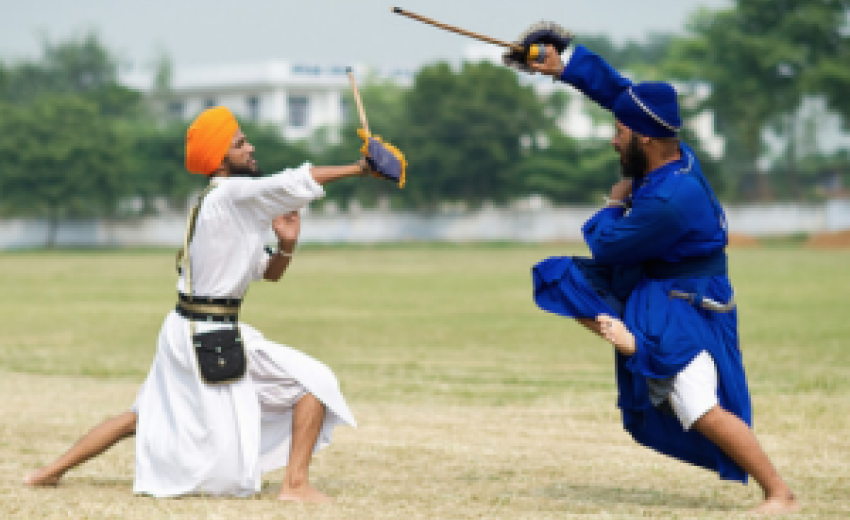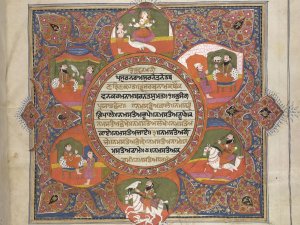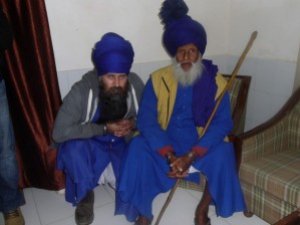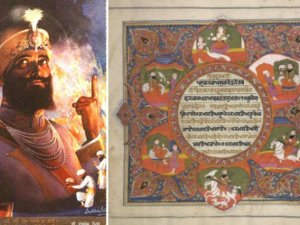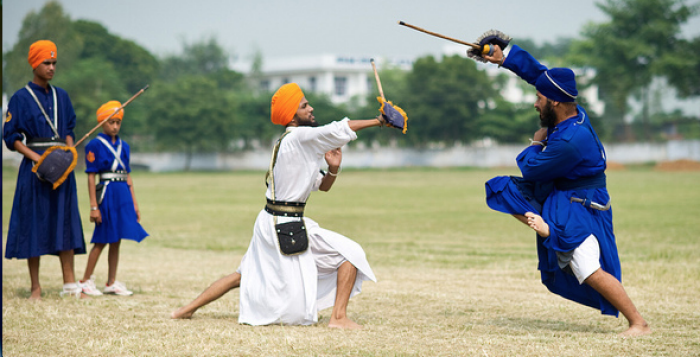
Gatka – A Martial Art that Empowers Our Life
July 29, 2015: Guru Ram Das created the Mal Akhara or Martial Arts School in Amritsar, and actually gave a turban of victory to Guru Arjan Dev, who won a great bout against a famous wrestler Maskeen. This martial arts school was inherited from Guru Angad Dev, who had learnt the art from Guru Nanak. Shabads in relation to this information can be found in Siri Guru Granth Sahib, and in early Sikh History. The Sixth Master then united Bhakti with Shakti, or spiritual devotion with physical empowerment. This unity of miri-piri is a key concept in the Sikh Dharma. In the Guru’s time, man was disempowered and had become weak, so the Guru wanted to give the Sangat and his new child, the Khalsa, a very important virtue which is courage. Siri Singh Sahib ~ Yogi Bhajan often talked of Gatka as ‘Adi-Shakti Yoga,’ or in other words a martial art which is a yoga of self empowerment. Gatka is not just a martial art, its a whole way of being, thinking, and living. Where each moment is to appreciate the temporal nature of reality, and thus to live a life full of creativity, beauty and joy. So much so that when facing death, one would approach it with courage, by living the right type of life or Dharma, called rahit maryada. It is a martial art, but it is also a spiritual practice, which aims to bring balance to our being. Gatka was employed in historical Sikh wars and has been thoroughly battle-tested, when there was a need to defend the dharma.
Those fortunate enough to have watched a Gatka display are mesmerised by the rhythmic movements. The sword turns swiftly in effortless circles with the beat of the drum, swords and shields strike each other, fast ḍhol or drums' rhythms resound, and jaikāre (war cries) are generously applauded by the martial artists and the Sangat!
Nowadays, it is very common in Sikh circles to use the word Gatka for all aspects of the Sikh martial art. In actual fact the term that is generally used for the art in historical sources is Shastravidiā, or the ‘Science of Weapons.’ Therefore, Gatka is only one component of the martial art system. There are a number of other components of Shastravidiā, which include unarmed combat, iron fist fighting, wrestling, and stick/club fighting (Gatka), weapon fighting, and missle fighting, respectively.
The difference between the performance of Gatka and Shastravidiā has been noted by traditional scholars. One is an exhibition art while the other is the lethal practical application or Jhaṭkā-Gatkā. Unfortunately, the majority of contemporary Gatka has become a form of exhibitionism.
The Basics of Gatka
The basic regime for fitness includes a healthy diet and physical exercises such as Sun salutations, Indian press up, and Squats. Gatka is primarily based on number of different paitarās and asanas, which are forms for coordinating the whole body and weapons in unison. The first is the Mūl paitarā which is a simple four-step pattern, and the key to all other forms. The movement requires equal and simultaneous use of both hands and develops ambidexterity. It is a balance and co-ordination exercise and is to be practised repeatedly. Then there are other paitarās based on the tiger, monkey, bull, snake, eagle, etc., that can also incorporate weapons. After the Ardās the warriors bow to the weapons and salute the arms, whilst either approaching the weapons or circumambulating them. Certain mantras are recited from the Dasam Granth Sahib, in particular the Shastra Nām Mālā, Tribhaṅgī Chhaṅd, Bhagautī Astora and Chaṇḍī dī Vār. There are also the war cries like Sat Sirī Akāl and Gurbār Akāl. Before sparring, both players must do the fatehnāmā, or salute each other by ritually crossing and hitting each other’s weapons twice. For more details see my article Kamalroop Singh, ’Sikh Martial Art (Gatka)’ in The Oxford Handbook of Sikh Studies, 2014.
About the author, his teachers and lineage
Kamalroop Singh is a student of Baba Pritam Singh Nihang and Baba Gian Singh Nihang (105 years old) both are students of the famous Baba Gian Singh ‘Rab’ pictured here. The great Nihang leader Baba Santa Singh spoke of him thus ‘Nihang Singh Baba Gian Singh is a old wise armed Singh, who knows Shastravidia very well, being a Master, he has taught THOUSANDS of Singhs Shastravidia.’ ‘Rabs’ lineage actually goes back in an unbroken golden chain to Guru Gobind Singh.
 |
 |
| Baba Pritham Singh, Patiala (left) and Baba Gian Singh | |
Baba Ji is 105 years old and an exponant of Jhatka Gatka, he reads a Panj Granthi and Das Granthi (lengthy Sikh prayer books) everyday at amritvela followed by practice of Gatka, he was a student of Sant Baba Gurbachan Singh Bhinderawale. He has trained many Singhs into skilled teachers of this art. May Guru Ram Das allow Baba Ji to keep inspiring us, and the best of health.

